Workplace Wellness Programs in 2025 (A Wellbeing Guide for Modern Businesses)
Last Updated Sep 17, 2025

It was only 9 a.m. on Monday, and Maya’s inbox was already a disaster. Missed deadlines. Stacks of sick notes. And a resignation from her top performer. By Thursday, she caught herself thinking burnout might as well be on the dress code.
She’s not alone. Across the U.S., leaders face the same storm—productivity slipping, healthcare costs climbing, morale tanking. Only 21% of employees believe their employer cares about their wellbeing. The impact shows up in turnover, engagement, and output.
Then Maya’s company made a bold move. They rolled out a real wellness strategy—mental health days, flexible schedules, fitness perks, and financial coaching. The results? Fewer sick days. Higher energy. More referrals from happy employees. And a level of loyalty she hadn’t seen in years.
Your workplace can have its own “Maya moment.” Elevate morale, performance, and retention with a wellness strategy that meets employees where they are. Discover how to turn wellbeing into your smartest competitive advantage yet.
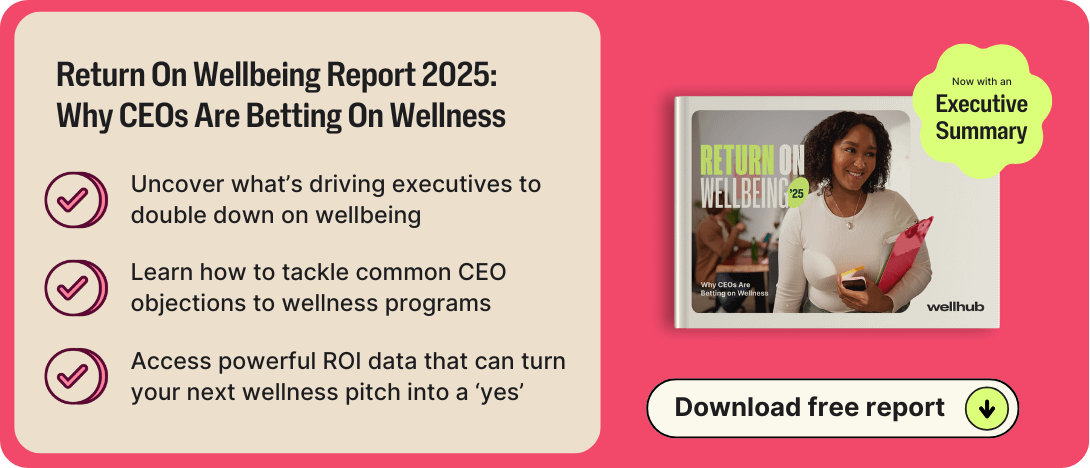
What is a Workplace Wellness Program?
A workplace wellness program is an employer-sponsored initiative designed to support and improve employees’ physical, mental, and emotional wellbeing.
These programs can include benefits, activities, and resources—such as fitness classes, mental health support, nutrition guidance, or flexible work policies—that aim to boost wellbeing, reduce stress, and enhance overall job satisfaction and performance.
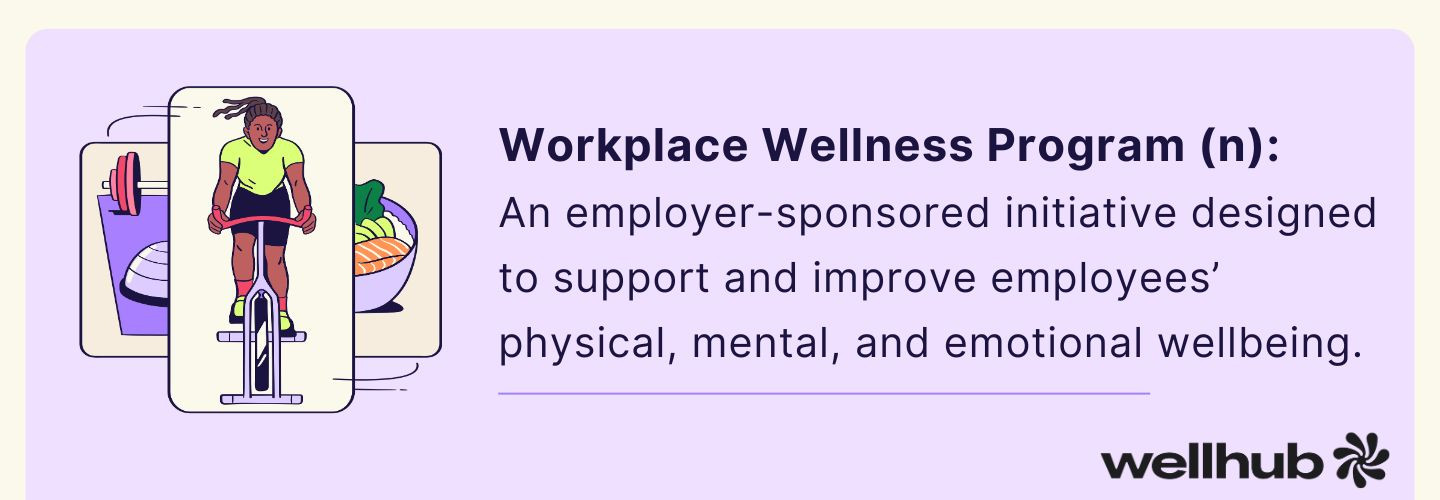
Benefits of Having a Workplace Wellness Program in Your Company (U.S. Statistics)
Wellness programs are no longer just feel-good initiatives — they’re directly linked to metrics that keep CEOs and CHROs up at night. Here’s why the most recent data shows that investing in employee wellbeing is mission-critical for modern businesses.
- Improved Engagement & Morale: When employees feel cared for, they’re far more engaged. In fact, 67% of employees at companies with wellness programs report liking their jobs more and are likely to recommend their employer. Conversely, only about 24% of workers overall strongly agree their organization cares about their wellbeing – a record low that drags down morale. By prioritizing wellness, leaders can boost day-to-day enthusiasm and create a workplace where people actually want to be.
- Reduced Healthcare Costs & Absenteeism: Employee illness and stress-related absences cost U.S. businesses billions each year. Effective wellness programs help turn that tide. Nine out of 10 of HR leaders say their company’s healthcare costs fell after implementing wellbeing initiatives (up from 78% a year prior). Similarly, 89% have seen employees take fewer sick days. Healthier employees mean lower insurance premiums, less absenteeism, and a significant reduction in “out sick” emails – all boosting the bottom line.
- Enhanced Productivity & Performance: Wellbeing and productivity go hand in hand. When people are healthy and not burned out, they can bring their best selves to work. It’s telling that 99% of HR leaders report wellness programs increase employee productivity. On the flip side, unchecked burnout is estimated to cost businesses $322 billion annually in lost productivity. By addressing root causes of stress and fatigue, wellness programs help employees stay focused, energized, and performing at their peak.
- Higher Retention & Talent Attraction: Employees today vote with their feet – and they’re gravitating to companies that value wellbeing. Nearly nine in 10 job seekers consider an employer’s benefits package (including wellness offerings) when evaluating a job. Over half of Gen Z and Millennials say wellness programs are extremely important in choosing where to work. Once on board, those with wellness support are less likely to leave; 98% of HR leaders credit wellbeing programs with reducing turnover. In fact, 83% say their wellness program is very or extremely important for talent acquisition. The takeaway: a robust wellness program is a talent magnet that also keeps your best people sticking around.
- Stronger Organizational Culture: A culture of wellness creates ripple effects across morale, teamwork, and company brand. Wellness initiatives – from team step challenges to volunteer days – build community and belonging, which in turn improve engagement and loyalty. Gallup identifies social and community wellbeing as two of the five essential elements of overall wellness. Companies with recognition-infused wellness programs see employees up to 10 times more likely to feel they belong. By supporting employees “as whole humans,” organizations cultivate a positive culture where people feel valued. This boosts resilience and adaptability in the face of challenges, forging a workplace that can weather storms with a smile.
Dive deeper into how workplace wellness can make your organization more successful.
Comprehensive Workplace Wellness Topics: Foundational Program Components
Today’s most successful wellness programs are holistic. They recognize that employee wellbeing has multiple dimensions – physical, mental, financial, social, and more – and that all these areas interconnect. A modern wellness strategy covers a range of topics and program components to address the “whole person.”
These are the core pillars of comprehensive workplace wellness, which together form the foundation of a modern strategy,
Physical Wellness Initiatives
Physical health may be the oldest pillar of corporate wellness, but it’s as critical as ever. With more than 42% of U.S. adults living with obesity, employers have both a responsibility and a business incentive to promote healthier lifestyles.
Today’s physical wellness programs go far beyond the office gym. Think virtual fitness classes, step challenges, nutrition counseling, healthy café menus, smoking cessation support, and on-site preventive care like flu shots and screenings. The payoff is real—Johnson & Johnson saved roughly $250 million in healthcare costs over a decade, earning $2.71 for every $1 invested in employee wellness. Wellhub research finds this isn’t a fringe result: Over half of companies see a return over 100% from their investment in a wellbeing program — meaning they get more than $2 back for every $1 invested. No wonder 58% of CEOs feel strongly that a employee wellbeing is critical to their organization's financial success!
The secret is making healthy choices the easiest ones. That could mean swapping standard desks for standing versions, upgrading to ergonomic workstations, or partnering with Wellhub to give employees access to gyms, studios, and sports worldwide. Physical wellness sends a clear message: you want your people to feel strong, energized, and ready for more than just the workday.
Get employees moving:
- 30 workplace wellness activities
- 17 plug-and-play physical wellness ideas
- 5 actionable employee fitness challenge ideas.
Mental & Emotional Wellbeing Support
Mental health has finally moved from the sidelines to the spotlight in workplace wellness. Stress, anxiety, and burnout are at record highs—81% of workers say job stress harms their mental health—and employees are demanding change.
Forward-thinking employers are delivering. Support now ranges from EAP counseling and mental health days to mindfulness apps, stress management workshops, and manager training in psychological safety. Just as important, companies are rethinking how work gets done: encouraging reasonable hours, enforcing unplugged vacations, and leading by example on work-life balance.
The most effective strategies pair prevention with culture. Mindfulness training and no-email-after-hours policies help employees recharge, while resilient, supported teams bring sharper focus and greater creativity. The business case is clear—92% of employees say mental health support is a key factor in choosing a job.
Strengthen workplace mental health:
- 7 proven strategies to strengthen emotional wellness at work
- Build psychological safety with these data-backed strategies
Financial Wellness Education
Money stress drains focus and fuels burnout—and it’s hitting employees hard. Nearly half of workers now say financial worries are a top cause of poor personal wellness, up sharply from 31% the year before. With inflation and economic uncertainty squeezing budgets, more than two-thirds of employees say financial stress distracts them at work.
No wonder financial wellbeing is now a must-have in workplace wellness.
Effective programs go beyond paychecks. Think budgeting workshops, one-on-one coaching, retirement and debt management tools, student loan repayment benefits, and guidance for big life goals like buying a home or funding college. The aim is simple: give employees the knowledge and resources to feel secure about their money.
The payoff is real. When financial stress goes down, focus and productivity go up—and retention improves. In fact, 84% of employers say financial wellness tools help reduce attrition.
Social & Community Engagement
Humans thrive on connection—and at work, belonging is a major driver of wellbeing. Social wellness programs can be playful or purposeful: team-building events, mentorship programs, Employee Resource Groups, volunteer days, and company-sponsored service projects. These moments forge relationships and give work deeper meaning.
The impact is measurable. Gallup finds employees without a sense of belonging are up to 12 times more likely to be disengaged. On the flip side, workplaces that celebrate milestones—birthdays, anniversaries, project wins—and encourage camaraderie see morale soar.
Social wellness isn’t fluff. It fuels collaboration, communication, and trust. Invest in community, and colleagues become more than coworkers—they become allies and friends united by a shared mission. And yes, as Gallup notes, having a “best friend at work” really does boost productivity and engagement.
Work-Life Wellness & Flexibility
Post-2020, work-life balance has evolved into work-life wellness—acknowledging that flexible, supportive arrangements are essential to wellbeing. This means flexible schedules, remote or hybrid options, generous caregiver leave, and clear boundaries (no midnight email expectations). It also means encouraging people to actually take their vacation and trying creative perks like “wellness Fridays” or shortened workweek pilots.
The data is clear: employees unable to work in their preferred environment aretwice as likely to struggle with wellbeing. When work setups fit their needs, stress drops and productivity rises. Flexibility isn’t one-size-fits-all—it’s a trust-based strategy that helps employees integrate work and life in healthy ways. No wonder 70% of employers now rank flexible work as “very” or “extremely” important.
Holistic strategy: By covering all five areas above, you address employees’ full spectrum of needs. And holistic programs truly get results – companies with four or more wellness offerings saw significantly higher ROI (with 24% of them achieving >150% returns) than those with only one or two offerings. The message is clear: a checkbox wellness program won’t cut it. A foundation of comprehensive, holistic wellness is now the gold standard.
Keep top talent inspired with this professional growth blueprint. [20 ideas]
Examples of Workplace Wellness Programs for Companies
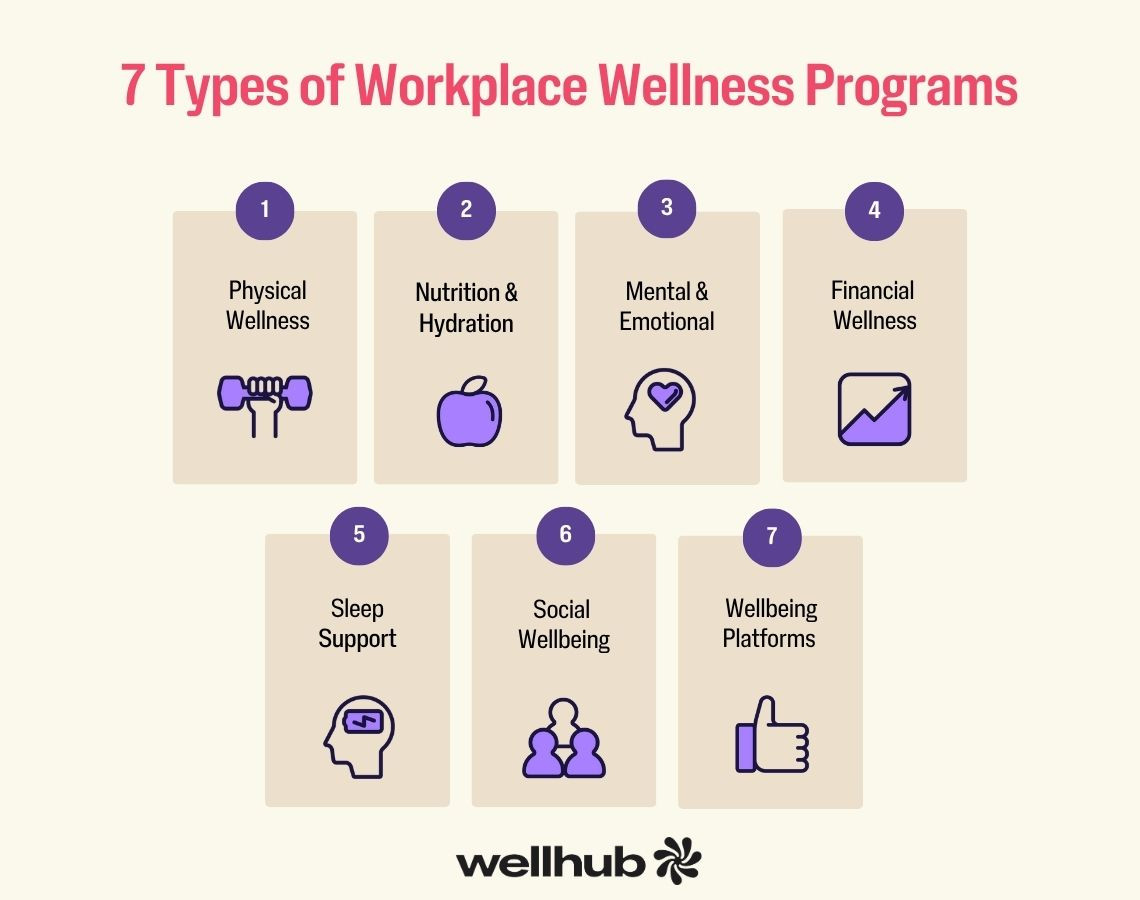
- Physical Wellness Initiatives
- Subsidized gym memberships — Offering financial support for gym memberships to encourage physical activity.
- Fitness challenges — Organizing activities like step-count competitions or group workouts to engage employees in fitness and teamwork.
- Ergonomic workspace upgrades — Providing ergonomic chairs, desks, and equipment to reduce physical strain and prevent injuries.
- Nutrition & Hydration Programs
- Healthy food options — Providing nutritious food and snack choices in cafeterias or vending machines to support employees’ health.
- Hydration challenges — Organizing activities to encourage regular hydration, boosting energy and focus.
- On-site nutrition counseling — Offering expert advice on nutrition to help employees make healthier food choices.
- Mental & Emotional Wellbeing Support
- Mindfulness and meditation tools — Providing resources like apps or classes to help employees manage stress and improve mental well-being.
- Therapy or counseling coverage — Offering access to therapy or counseling services to support employees’ emotional health.
- Resilience training — Providing training programs that help employees build resilience and cope with challenges effectively.
- Sleep & Recovery Programs
- Sleep health education — Offering resources to educate employees on the importance of sleep and how to improve sleep quality.
- Nap pods or quiet rooms — Creating spaces where employees can take short naps or find quiet for relaxation.
- Flexible scheduling — Allowing employees to adjust their work hours to support better sleep patterns.
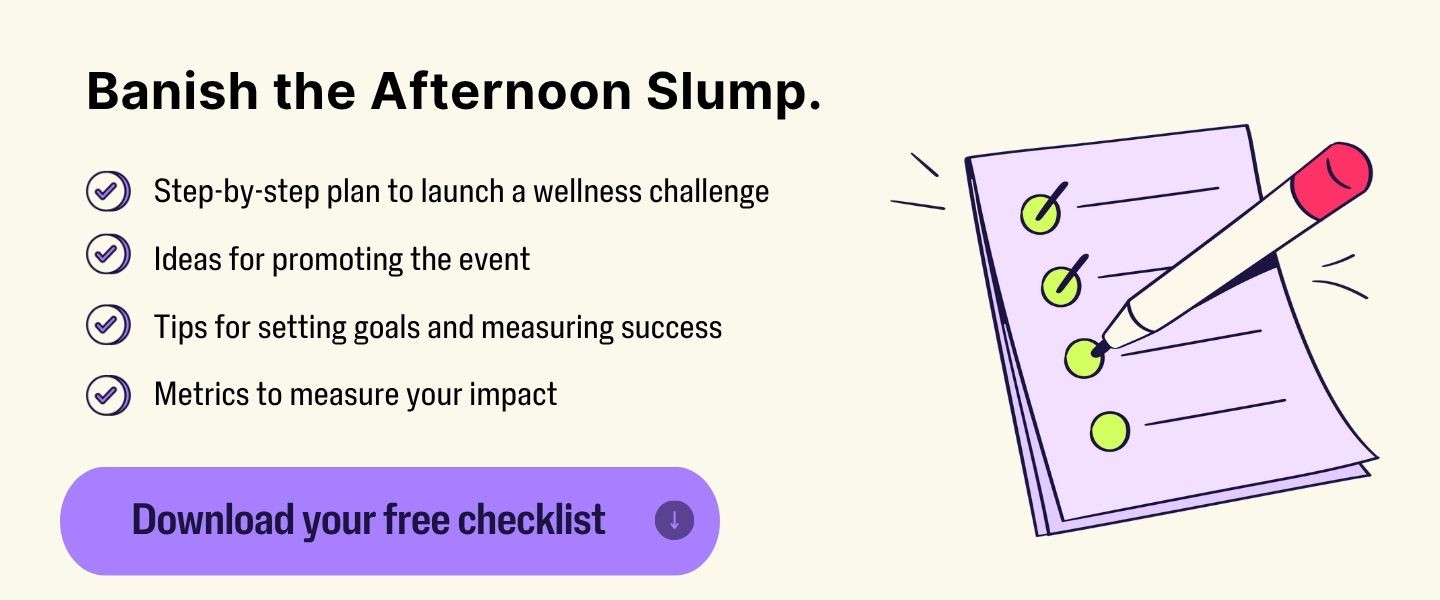
- Financial Wellness Programs
- Financial literacy workshops — Providing educational resources to help employees manage their finances effectively.
- Debt management and retirement tools — Offering support for managing debt and planning for retirement, reducing financial stress.
- Social & Community Wellbeing
- Volunteer time off (VTO) — Giving employees paid time off to volunteer and engage in charitable activities.
- Team-building events — Organizing events that encourage collaboration and strengthen team bonds.
- Mentorship programs — Creating opportunities for employees to mentor others or receive guidance to develop their skills and careers.
- Holistic Corporate Wellbeing Platforms
- Comprehensive wellbeing memberships — Providing access to platforms that integrate physical, mental, and social wellness resources into a single, accessible service.
- Integrated wellness resources — Offering a variety of tools and programs that support employees’ overall wellbeing in a flexible and inclusive manner.
Get started with 30 workplace wellness activitiesor 57 workplace wellness initiatives.
Keys of Wellness Program Strategic Implementation
Designing a great wellness program is one thing. Implementing it successfully is another. Busy HR leaders know that without the right strategy, even the best ideas can fall flat. Here’s a step-by-step blueprint (A–F) for rolling out a wellness program that actually sticks – from getting leadership on board to leveraging technology:
Gaining Leadership Buy-in
For wellness to stick, you need leaders who don’t just sign off—they show up. C-suite buy-in early is critical because leaders set the tone. When executives attend wellness events or take mental health days themselves, employees feel permission to prioritize self-care without stigma. The impact is dramatic: executive participation can drive employee engagement in wellness programs from 44% to 80%.
To win over your CEO or CFO, make the business case. Show how wellness links to retention, productivity, and cost savings—95% of companies that measure ROI report positive returns. Share success stories from peer companies or results from an internal pilot. Frame wellness as a strategic investment, not a cost center.
If you face skepticism, start small with an executive-focused initiative—like a leadership step challenge—to spark personal engagement. Once leaders are walking the talk, securing budget and company-wide buy-in becomes far easier. And with four in five HR leaders now ranking mental health and wellbeing as top priorities, the momentum is already on your side.
Conducting a Needs Assessment
Before launching—or overhauling—a wellness program, find out what your employees actually need. Surveys, focus groups, benefits usage analysis, and demographic data can reveal the real priorities. Ask about their biggest wellness challenges—stress, work-life balance, fitness, finances—and the resources they’d value most. You might plan yoga classes, only to discover employees want financial coaching or better remote-work support.
Health data can also surface hidden needs. Aggregate reports from insurers or EAP usage stats might show high mental health claims or low participation. Awareness is often the problem—31% of employees don’t know if their company offers an EAP, and 81% of those with one have never used it.
The goal is simple: design your program around real pain points. If lack of sleep is common, consider a sleep challenge or even nap pods. A thoughtful needs assessment ensures your wellness strategy is relevant, targeted, and far more likely to make an impact.
Designing Inclusive & Accessible Programs
Inclusive wellness means every employee can participate—regardless of location, role, age, ability, or background. That can mean translating materials, scheduling events across shifts, and offering options for both remote and on-site teams. Activities should be adaptable: a step challenge might include alternative activities for employees with mobility limitations. Under the ADA, you must provide reasonable accommodations or alternative ways to earn incentives if any part of your program isn’t accessible.
Accessibility also means user-friendly tech and flexible timing so employees can engage when and how it works for them. Companies are increasingly offering a “menu” of wellness options—physical, mental, financial—so employees can choose what resonates. Lifestyle spending accounts take personalization even further, letting people tailor benefits to their own needs.
The bottom line: meet employees where they are. If your wellness program only appeals to a small slice of your workforce, you’ll miss the impact. Inclusive programs send a clear message—everyone’s wellbeing matters.
Effective Communication & Promotion
Many wellness programs fail for one simple reason: no one knows about them. Busy employees won’t magically stumble onto your offerings—you have to market them internally with the same energy you’d sell to customers.
Create a multi-channel plan: emails, intranet posts, Slack or Teams messages, breakroom posters, manager shoutouts, even videos or wellness fairs. Always lead with “what’s in it for me?”—share success stories (“The Finance 101 webinar helped Anna save for a house”) or eye-catching stats (“Employees in our program report 40% less stress”). Keep the tone upbeat and inclusive, never preachy.
Make participation effortless with clear instructions, quick sign-ups, and 24/7 access. Consider a high-energy kickoff—like a wellness week with activities and giveaways to build buzz. Then keep momentum alive by celebrating milestones (“1,000 collective miles walked this month—great job, team!”).
Strong communication can lift participation well above the typical 20 to 40%. Incentives help, but they’re not enough—61% of large employers say financial rewards alone don’t move the needle. The real driver is showing employees these programs genuinely make their lives better. Communicate, remind, reinforce, and watch engagement grow.
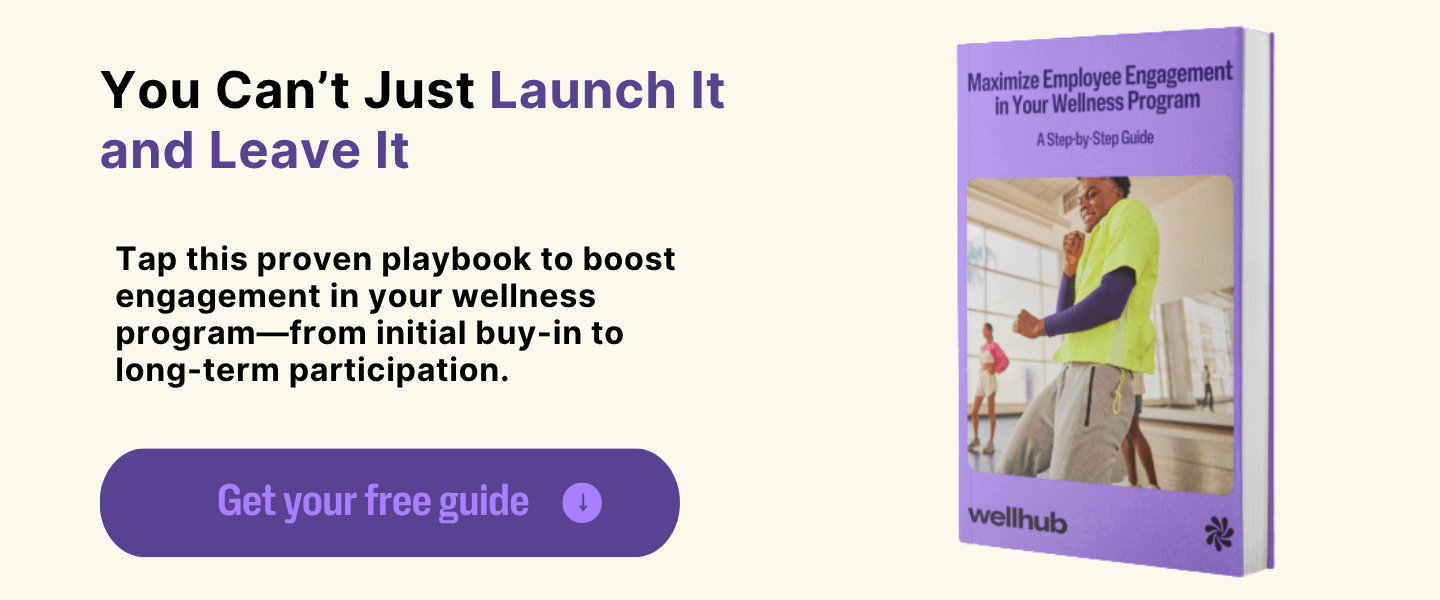
Incentives & Recognition
Incentives can give your wellness program a lift—but they should be the bonus, not the foundation. Gift cards, premium reductions, cash bonuses, extra PTO, company swag, wellness points, or leaderboard shoutouts can nudge hesitant employees to join a steps challenge or complete a health assessment.
The most effective incentives are inclusive and achievable. Reward progress and consistency—like exercising three times a week—rather than only top performance, which can favor those already in peak shape. Tie wellness to recognition: highlight teams that improve their fitness together or employees who champion mental health awareness. Workhuman/Gallup research shows regular recognition reduces burnout—why not celebrate wellness wins as you would sales milestones? Even a shout-out from the CEO can make participation feel valued.
Gamification adds another spark. Badges, challenges, and interdepartmental competitions with fun prizes build motivation and camaraderie. Always frame incentives around the real prize—better health and happiness—and avoid penalizing those who opt out. Done right, incentives and recognition create positive buzz and momentum that keep your program thriving.
Leveraging Technology
Technology is your friend in scaling and sustaining a modern wellness program – especially for dispersed or large workforces. Wellness tech ranges from app-based platforms to wearable devices to AI-driven health coaches.
A good wellness platform (like Wellhub or others) can centralize offerings (fitness classes, therapy sessions, financial tools, etc.) in one hub, personalize recommendations to each employee’s goals, and provide real-time data on participation and outcomes. In 2024 and beyond, companies are heavily investing in digital wellness solutions: 91% of employers planned to increase investment in mental health apps and platforms, and 66% in stress management and resilience tools. These tools meet employees where they are – often literally on their smartphones – and make engaging in wellness as convenient as scrolling Instagram.
Wearables and fitness trackers can be great for friendly competitions (steps, anyone?) and for employees to monitor their progress. AI is starting to play a role through chatbots or programs that can tailor wellness content to individual needs (for example, an AI coach suggesting a meditation break when your calendar looks hectic).
Beyond front-end engagement, tech also gives HR leaders data insights. You can track which programs are most used, what times see peak engagement, and even correlate wellness participation with HR metrics (did that new yoga offering coincide with a drop in sick days?).
Be mindful of data privacy – ensure any tech vendor is compliant with regulations like HIPAA if health data is involved, and communicate to employees how their data is used (usually aggregate usage stats, never personal info without consent). In short, leverage technology to make wellness easy, fun, and measurable. A slick user experience can significantly increase participation – and a solid dashboard of analytics will help you continuously refine and prove the impact of your program.
7 Tips for Running a Successful Wellness Program
Running a workplace wellness program requires building a living, breathing system that adapts to your people’s needs and consistently drives results
Leverage these strategies to make sure your initiative thrives, not fizzles.
- Integrate Wellness Into Everyday Workflows
Don’t silo wellness into optional add-ons. Embed micro-wellbeing moments into regular meetings, team stand-ups, or lunch breaks. For example, start a Monday meeting with a two-minute breathing exercise or close a Friday recap with a group gratitude share. This normalizes self-care as part of the workday rather than an extracurricular.
- Leverage Peer-Led Programming
Empower employees to run sessions based on their own expertise or passions — from cooking demos to walking clubs. Peer-led options boost authenticity and can increase engagement by showing wellness isn’t just “from HR” but from colleagues who share similar challenges and wins.
- Host Wellness Challenges
Design time-bound wellbeing challenges that spark friendly competition and keep wellness top of mind. Challenge ideas include step-count showdowns, mindfulness streaks, or healthy recipe swaps. Make them inclusive, fun, and reward participation to build momentum and community around wellbeing.

- Make Managers the First Line of Wellbeing Support
Provide manager-specific training to spot early signs of burnout, poor morale, or stress in their teams — and equip them with practical next steps. Managers are often the first to notice shifts in performance or mood, making them a critical link in proactive intervention.
- Create “Recovery Zones” in Physical or Digital Spaces
For in-office staff, set up calming areas with low lighting, comfortable seating, and mindfulness tools. For remote employees, offer a digital library of quick restorative activities like guided stretches or five-minute meditations. Both options give employees accessible spaces to reset during the workday.
- Link Wellness Goals to Broader Company Missions
Tie your wellness initiatives to your organization’s purpose. For example, a company focused on sustainability could run a “bike-to-work” month that supports both environmental impact and employee health. When employees see how wellness aligns with company values, engagement deepens.
- Rotate Offerings Quarterly to Prevent Stagnation
Avoid program fatigue by changing focus every few months — for instance, Q1 could highlight nutrition, Q2 movement, Q3 financial health, and Q4 emotional resilience. A rotating spotlight keeps the program feeling fresh and relevant while covering all dimensions of wellbeing.
We made it easy: Launch your wellness program with this step-by-step guide.
Measuring Wellness Programs: KPIs to Calculate ROI
You can’t manage what you don’t measure. To keep executive support (and your own confidence) high, it’s vital to track key performance indicators (KPIs) for your wellness initiatives and calculate their return on investment (ROI). Here’s how to quantify success:
Key KPIs
Identify a mix of hard metrics and soft metrics that align with your program goals. Hard metrics might include healthcare cost trends (e.g. changes in per-employee insurance costs year over year), absenteeism rates, employee turnover rates, and productivity measures (like sales per employee or customer satisfaction, if you can tie those to wellness efforts). Soft metrics include employee engagement scores, self-reported wellbeing levels from surveys, and program participation rates.
Some popular KPIs include:
- Participation rate – percentage of employees who regularly use wellness offerings
- Program completion rate – percentage of participants who finish specific programs (e.g., an 8-week financial wellness course)
- Health outcomes – aggregate improvements such as reduced hypertension or lower BMI among health screening participants
- Absenteeism – total days lost to illness
- Presenteeism – self-reported productivity losses due to health issues
- Employee retention – percentage of employees who remain with the company during a given period
If you have baseline data from before the program, even better – you can compare pre- and post-implementation. For instance, if turnover was 15% and dropped to 10% after introducing a wellness platform, that’s a tangible win.
As noted in Wellhub’s Return on Wellbeing 2024 report, 77% of companies reported overall ROI >100% (i.e. getting more than $1 back for every $1 spent) on their wellness program – an encouraging benchmark. To calculate ROI, you’ll be quantifying things like cost savings from reduced healthcare claims and turnover against program expenses. (We’ll touch on that in the “Iteration and Evolution” subsection below.)
Gathering Employee Feedback
Numbers aside, employee feedback is an essential metric of success. After all, a wellness program exists to serve your people.
Use surveys, polls, or focus groups to gauge how employees feel about the program. Are they finding it valuable? Has it improved their stress levels, health habits, or morale? What do they want more (or less) of? This qualitative data provides context for the KPIs. For example, your hard data might show 60% of employees used a new meditation app – but did it actually help them feel better?
Feedback will tell you if, say, employees loved the guided sessions but wish they were shorter, or if some stopped using it because of technical issues. Also ask how supported employees feel by leadership in their wellbeing; as we saw, only about one in five employees currently strongly feel their employer cares, so improving that sentiment is a worthy goal to track.
Gathering testimonials or success stories is powerful too – it puts a human face to the ROI. Maybe an employee shares that the financial coaching helped them get out of debt, or a team fun run event brought colleagues closer. These narratives can be shared with execs (and in internal comms) to reinforce why the wellness program matters. In short, listen to your employees – their experience is the ultimate barometer of your program’s value.
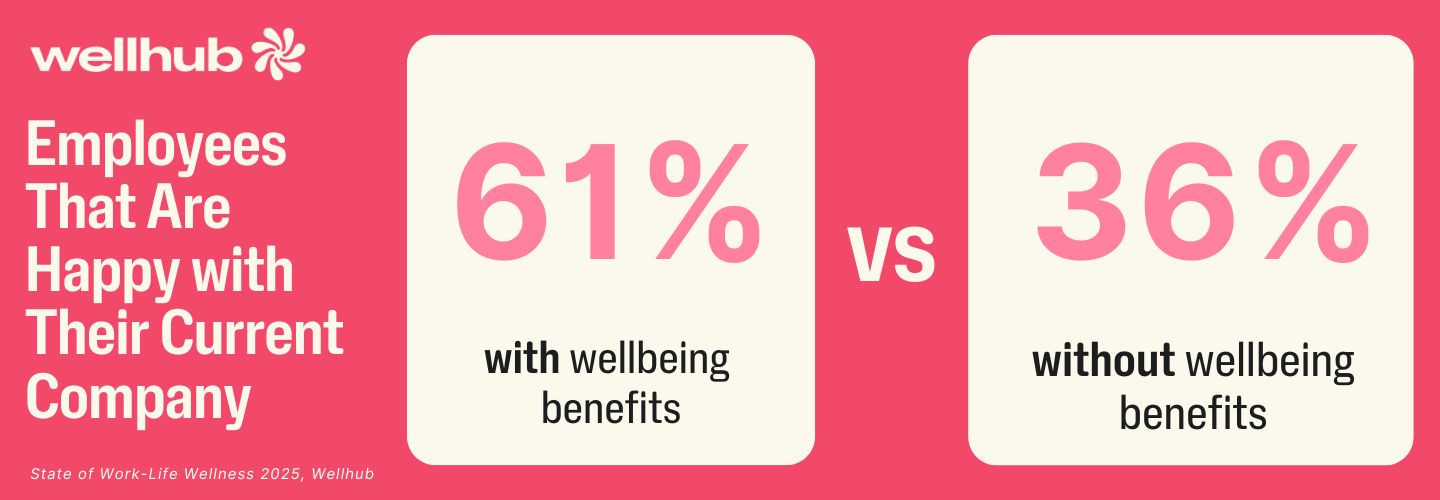
Iteration and Evolution
Measurement isn’t just for proving past success – it’s for continuously improving your wellness strategy. Use your KPI data and feedback to iterate. If participation in a certain offering is low, dig into why: was awareness low, or was the offering not appealing? Maybe your monthly wellness newsletter has a low open rate – perhaps switching to bite-sized weekly tips or a social media-style feed could work better. Or your data might reveal one department lags in participation; that could signal certain managers need to be more encouraging, or that those employees have schedules that conflict with events.
Also pay attention to outcome metrics: if stress levels aren’t budging or healthcare costs are still climbing, it might be time to introduce new interventions targeting the specific issues (for example, a sleep awareness campaign if lack of sleep is still a top problem).
Benchmark against external data when possible: E.g., if industry turnover is 12% and you brought yours down to 8%, that’s a great story to tell. Conversely, if others see healthcare cost decreases of 5% and you don’t, investigate and adjust.
Treat your wellness program as a living, breathing initiative that evolves with your workforce. Each year (or quarter), review what’s working and what’s not. Then refine goals and programs accordingly. This agile approach not only improves results but also shows employees you’re responsive – you’re not just set-and-forget, you truly care about maximizing the program’s impact on them. Ultimately, iteration will help you maintain strong ROI and VOI (value on investment) over the long haul, keeping the wellness program aligned with both employee needs and business objectives.
Launch a wellness program thatlifts engagement and lowers costs.
Navigating Legal & Compliance: U.S. Workplace Wellness Program Regulations
Wellness programs touch on personal health data and benefits – an area rife with regulatory considerations. U.S. HR leaders must navigate various legal and compliance requirements to ensure their wellness initiatives are safe, fair, and lawful.
Here’s a rundown of few key guidelines:
Understanding Regulatory Frameworks (HIPAA, ACA, ADA, etc.)
Multiple federal laws set the guardrails for wellness programs. The big ones include:
- HIPAA (Health Insurance Portability and Accountability Act): HIPAA’s nondiscrimination rules say health plans can’t discriminate based on health factors. Wellness programs that tie incentives to health outcomes (e.g. biometric screenings, BMI targets) must meet certain requirements to be compliant. For instance, if you offer a premium discount for hitting a cholesterol goal, you also must offer a reasonable alternative for those who can’t meet that goal (like a doctor’s note or an alternative activity). HIPAA also requires protecting any personal health information gathered – more on privacy in the next sub-section.
- ACA (Affordable Care Act): The ACA built on HIPAA’s rules, basically allowing wellness incentives up to a certain limit (generally up to 30% of the total cost of health coverage) for health-contingent programs, provided those five conditions (frequency, size of reward, reasonable design, alternative standards, notice) are met. Participatory wellness programs (not health-contingent) have more leeway. The ACA firmly establishes that such programs must be voluntary and non-coercive in nature.
- ADA (Americans with Disabilities Act): The ADA comes into play if your program involves any medical inquiries or exams (like health risk assessments, biometric screenings, or questionnaires about health conditions). Under the ADA, participation in such programs must be voluntary – you can’t require employees to disclose medical info or penalize them heavily for not doing so. The EEOC (Equal Employment Opportunity Commission) has issued guidance that any incentive tied to ADA-protected information should not be so large as to be coercive. Also, you must provide reasonable accommodations: e.g., if a disability prevents someone from participating in a fitness challenge, allow an alternative way to earn any reward.
- GINA (Genetic Information Nondiscrimination Act): Be careful not to ask for family medical history or genetic data as part of wellness programs – or if you do (say, a family health history as part of an HRA), have explicit, voluntary consent and don’t offer incentives for that piece. GINA protects employees (and their families) from discrimination based on genetic information.
- ERISA (Employee Retirement Income Security Act): If your wellness program is linked to a group health plan (many are), it likely falls under ERISA’s umbrella. That means you may need to distribute plan documents/SPDs and abide by ERISA’s reporting rules. Integrating the wellness program with your health plan can also extend certain legal protections.
- State Laws: Don’t forget to check state-specific laws. For instance, some states restrict wellness program incentives (e.g., limiting tobacco cessation incentives), and others have privacy laws (like California’s CPRA) affecting how you handle employee wellness data. Always stay updated on your state’s stance.
In short, ensure your wellness program is voluntary, non-discriminatory, and provides alternatives for those who can’t meet standard goals. When in doubt, get legal counsel to review your program design – especially if you’re using incentives tied to health outcomes.
Data Privacy & Security
Wellness programs sometimes collect sensitive personal data – from health stats (heart rate, steps, glucose readings) to counseling usage. Protecting this data is paramount. HIPAA has strict rules for any wellness program that is part of a group health plan (or that handles personal health information through a healthcare provider or insurer). Ensure that any health information is stored and transmitted securely (think encryption, secure databases) and only accessed by those who need to know. For example, if you run a biometric screening, the vendor might provide individual results to employees privately and only aggregate data to the employer. As HR, you generally should avoid viewing individual health data to respect privacy and avoid liability.
Communicate clearly to employees what data is collected, how it will be used, and who sees it. Typically, employers receive only de-identified, aggregate reports (e.g. “30% of our employees have elevated blood pressure”) and use that to shape programs. If you use wellness apps or wearable devices, vet the vendors: do they have certifications or compliance attestation for data security? Are they selling data to third parties (a no-no for something you sponsor)? Also, consider privacy laws like the California Consumer Privacy Act (if applicable) – employees might have rights to know or delete personal data held by wellness platforms.
A best practice is to treat wellness data with the same care as HR data or medical records. Have a privacy policy for your program, and ensure any third-party partners sign confidentiality agreements.
By making privacy a priority, you build trust: employees will be more willing to engage when they’re confident their personal info won’t end up on the office bulletin board or, worse, in a breach headline. In summary, lock down your data – it’s both a legal requirement and the right thing to do.
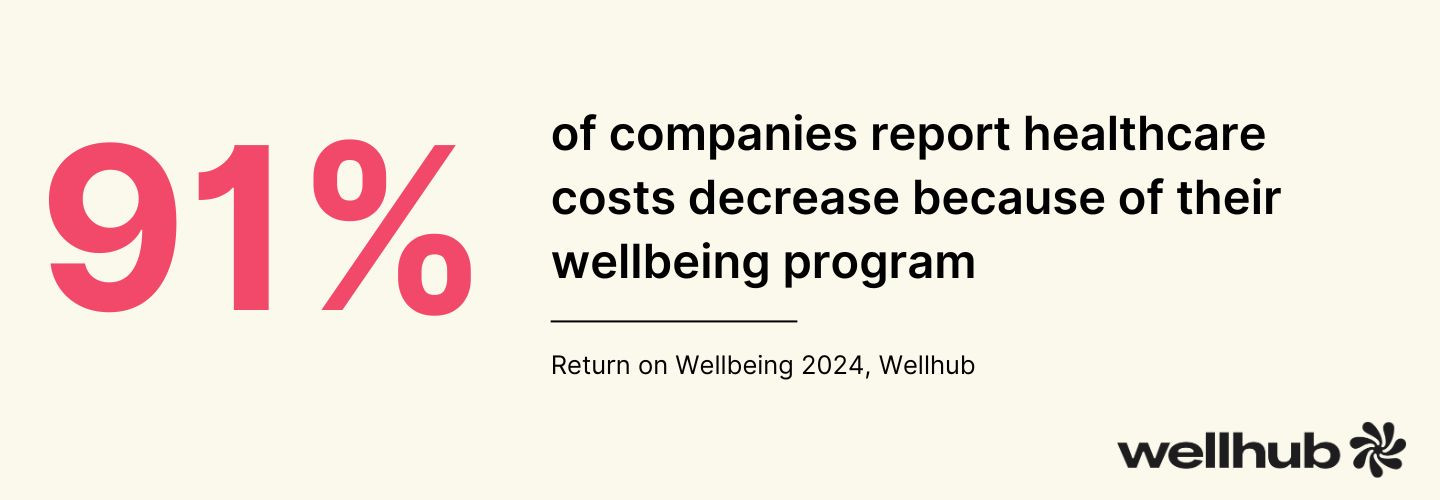
Ethical Considerations
Legal compliance is the baseline—ethical wellness goes further. One pitfall to avoid is carewashing: promoting wellness perks while ignoring the root causes of employee stress. Offering meditation apps while piling on impossible deadlines only breeds cynicism. Real care pairs perks with meaningful change—reasonable workloads, enforced rest, and a respectful culture.
Respecting boundaries is key. Encourage participation, but never pressure it. Avoid shaming those who opt out of fitness challenges or other activities. Choice should come from positive encouragement, not fear of losing favor or rewards.
Inclusion matters, too. Make sure programs welcome everyone. A happy hour may exclude employees who don’t drink or have family commitments. Weight-loss contests can alienate those with eating disorders or who view them as body-shaming. Focus instead on holistic health goals and personal bests.
Be transparent about what your program can—and can’t—deliver. Acknowledge external stressors and invite honest feedback. Keep incentives modest and ethical; the EEOC advises they should never be so large that employees feel coerced, especially around health disclosures.
Done right, ethical wellness programs build trust, foster genuine engagement, and show employees your commitment runs deeper than a checkbox.
By keeping ethics front and center, you ensure your wellness program truly supports employees’ wellbeing and respects their dignity, rather than just serving the company’s interests. The payoff is trust – and a program employees embrace with enthusiasm, not skepticism.
Emerging Trends in Workplace Wellness
The wellness landscape is continually evolving. As we look at 2025 and beyond, several emerging trends are shaping how companies approach employee wellbeing. HR leaders (especially at multinationals) should keep these in mind to stay ahead of the curve:
Personalized & AI-Driven Wellness
The one-size-fits-all wellness program is over. The future is hyper-personalized, powered by artificial intelligence and real-time data.
Picture a wellness app that builds a daily plan for each employee. It might suggest a stretch break when a posture sensor shows they’ve been sitting too long, or prompt a financial tip after they attend a retirement webinar. Many companies already use AI coaches and recommendation engines that match resources to personal goals. A runner training for a 5K might see local running clubs and endurance nutrition tips. A stressed-out teammate could be served guided meditations and breathing exercises.
Lifestyle Spending Accounts (LSAs) take personalization even further. Instead of preset benefits, employees get a budget to spend on what matters most—gym memberships, music lessons, even pet therapy. This shift gives employees more control over their wellness journey. For employers, AI analytics surface patterns that can boost performance, like noticing that midday workouts drive higher afternoon productivity.
Done well, personalization feels like a concierge service. Every employee sees a program built for them, making wellness more engaging, more effective, and far from a generic checklist.

Mental Wellness as a Core Pillar
If the 2010s put mental health on the workplace agenda, the mid-2020s made it the cornerstone of employee wellbeing. The pandemic spotlighted anxiety, depression, and burnout, and companies are acting. In 2025, 86% of brokers reported that their clients are boosting investment in mental health solutions, with even stronger growth in related categories like stress management (70%) and mindfulness (55%)
Support now goes far beyond EAPs. Organizations are normalizing mental health days, training managers to spot distress, and adding on-demand therapy or coaching to benefits. Many focus on prevention, with resilience training, mindfulness breaks, and cultures where it’s safe to say, “I’m feeling overwhelmed.” Burnout prevention is front and center, tackled through workload reviews, clearer job expectations, and stronger PTO use.
The conversation has widened to holistic mental wellness, including emotional health, purpose, and even spiritual wellbeing through practices like meditation and reflection. Leaders are also reducing stigma by sharing their own stories, making it easier for employees to seek help.
The payoff is clear: employees who feel supported are less likely to burn out and more likely to be engaged. Ninety-five percent say emotional wellness boosts their productivity and job satisfaction.
For HR leaders, the takeaway is simple—mental wellness isn’t a side note to physical health. It’s a driver of both wellbeing and performance.
Global Wellness Strategies (Multinational Employers)
For multinational companies, wellbeing now demands a global vision with local execution. A recent survey found 93% of employees worldwide view wellbeing as important as salary, but what “wellness” means varies by culture.
The emerging approach is glocalization—setting a unified wellbeing strategy, then tailoring it to regional needs. A global goal to improve work-life balance might mean mandatory vacation policies in one country and expanded childcare support in another. Core benefits like mental health services or fitness access are offered everywhere, even if delivered through different providers.
Technology makes this scalable, with platforms offering multilingual content and time zone–friendly events. Ideas also cross borders: a “no-meeting Wednesday” pilot in one market might become a company-wide staple. Compliance is key, especially with regional rules like Europe’s GDPR or France’s “right to disconnect” law, which often set higher standards for all locations.
Some wellness challenges are universal—stress, sleep, financial strain—while others are regional, like air quality concerns in certain cities. By analyzing local wellbeing data, employers can target interventions where they matter most. The result is a consistent commitment to employee care worldwide, anchored by the message: No matter where you work, we’ve got you.
Make Wellness Your Strategic Advantage
Engagement dips, healthcare costs rise, productivity drops, and turnover spikes — these challenges hit every HR leader’s radar. This article shows how a thoughtful, holistic wellness program can address them head-on while strengthening culture and talent attraction.
An employee wellbeing program creates measurable impact across all these areas. By giving employees tools to support their physical, emotional, financial, and social health, you help them show up energized and engaged. The payoff is clear — companies with strong wellness programs can see turnover drop by up to 40% and healthcare costs fall by as much as 35%. That’s a direct boost to morale, retention, and the bottom line.
Speak with a Wellhub Wellbeing Specialist to design a program that powers performance, attracts top talent, and builds a culture people don’t want to leave.

Company healthcare costs drop by up to 35% with Wellhub*
See how we can help you reduce your healthcare spending.
Category
Share

The Wellhub Editorial Team empowers HR leaders to support worker wellbeing. Our original research, trend analyses, and helpful how-tos provide the tools they need to improve workforce wellness in today's fast-shifting professional landscape.
Subscribe
Our weekly newsletter is your source of education and inspiration to help you create a corporate wellness program that actually matters.
Subscribe
Our weekly newsletter is your source of education and inspiration to help you create a corporate wellness program that actually matters.
You May Also Like

Corporate Wellness Trends HR Must Know for 2026 | Wellhub
See the top 2026 wellness trends shaping performance, retention, and culture—plus how HR can build a unified, ROI-driven wellbeing strategy.

Wellness Points Programs: Boost Employee Health & Engagement | Wellhub
Turn your workplace wellness strategy around with a points program that rewards healthy behavior with perks, from extra time off to gift cards.

Employee Financial Wellness Programs: Ultimate HR Guide | Wellhub
Create an effective financial wellness program that supports your employees in their financial needs, boosting productivity and retention.